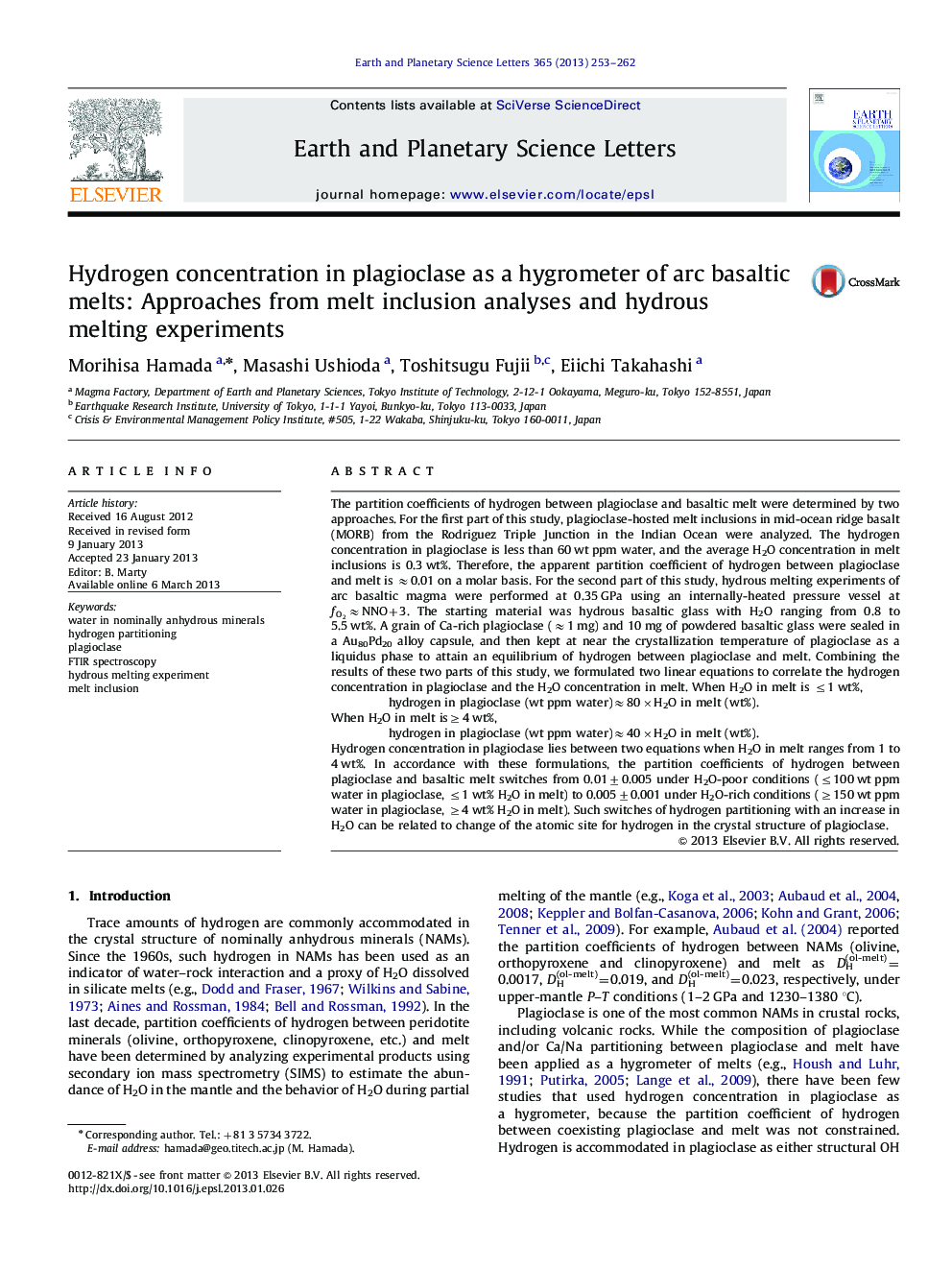| Article ID | Journal | Published Year | Pages | File Type |
|---|---|---|---|---|
| 4677146 | Earth and Planetary Science Letters | 2013 | 10 Pages |
The partition coefficients of hydrogen between plagioclase and basaltic melt were determined by two approaches. For the first part of this study, plagioclase-hosted melt inclusions in mid-ocean ridge basalt (MORB) from the Rodriguez Triple Junction in the Indian Ocean were analyzed. The hydrogen concentration in plagioclase is less than 60 wt ppm water, and the average H2O concentration in melt inclusions is 0.3 wt%. Therefore, the apparent partition coefficient of hydrogen between plagioclase and melt is ≈0.01 on a molar basis. For the second part of this study, hydrous melting experiments of arc basaltic magma were performed at 0.35 GPa using an internally-heated pressure vessel at fO2fO2≈NNO+3. The starting material was hydrous basaltic glass with H2O ranging from 0.8 to 5.5 wt%. A grain of Ca-rich plagioclase (≈1 mg) and 10 mg of powdered basaltic glass were sealed in a Au80Pd20 alloy capsule, and then kept at near the crystallization temperature of plagioclase as a liquidus phase to attain an equilibrium of hydrogen between plagioclase and melt. Combining the results of these two parts of this study, we formulated two linear equations to correlate the hydrogen concentration in plagioclase and the H2O concentration in melt. When H2O in melt is ≤1 wt%,hydrogen in plagioclase (wt ppm water)≈80×H2O in melt (wt%).When H2O in melt is≥4 wt%,hydrogen in plagioclase (wt ppm water)≈40×H2O in melt (wt%).Hydrogen concentration in plagioclase lies between two equations when H2O in melt ranges from 1 to 4 wt%. In accordance with these formulations, the partition coefficients of hydrogen between plagioclase and basaltic melt switches from 0.01±0.005 under H2O-poor conditions (≤100 wt ppm water in plagioclase, ≤1 wt% H2O in melt) to 0.005±0.001 under H2O-rich conditions (≥150 wt ppm water in plagioclase, ≥4 wt% H2O in melt). Such switches of hydrogen partitioning with an increase in H2O can be related to change of the atomic site for hydrogen in the crystal structure of plagioclase.
graphical abstractCorrelation between hydrogen concentration in Ca-rich plagiuoclase and H2O concentration in basaltic melt has been constrained based on two parts of studies: (i) analyses of low-H2O melt inclusions hosted by plagioclase and (ii) hydrogen partitioning experiments between plagioclase and melt. Obtained formulations arehydrogen in plagioclase (wt ppm water)≈80×(H2O in melt, wt%) under H2O-poor conditions (≤100wtppm water in plagioclase, ≤1wt% H2O in melt)hydrogen in plagioclase (wt ppm water)≈80×(H2O in melt, wt%) under H2O-poor conditions (≤100wtppm water in plagioclase, ≤1wt% H2O in melt)andhydrogen in plagioclase (wt ppm water)≈40×(H2O in melt, wt%) under H2O-rich conditions (≥150wtppm water in plagioclase, ≥4wt% H2O in melt).hydrogen in plagioclase (wt ppm water)≈40×(H2O in melt, wt%) under H2O-rich conditions (≥150wtppm water in plagioclase, ≥4wt% H2O in melt).Experimental data lies between two lines with intermediate H2O in melt (1–4 wt%) (Fig. 5a in main text). In accordance, partition coefficient of hydrogen between plagioclase and melt decreases from 0.01±0.005 under H2O-poor conditions to 0.005±0.001 under H2O-rich conditions (Fig. 5b in main text). Such switch of hydrogen partition coefficient with increasing H2O can be related to changes in hydrogen site in the crystal structure of plagioclase.Figure optionsDownload full-size imageDownload high-quality image (84 K)Download as PowerPoint slideHighlights► Ca-rich plagioclase was experimentally hydrated by H2O-undersaturated basaltic melt. ► Hydrogen concentration in plagioclase serves as a hygrometer of arc magmas. ► Hydrogen partition coefficients switches and decreases with increasing H2O in melt.
